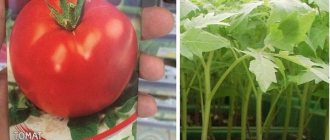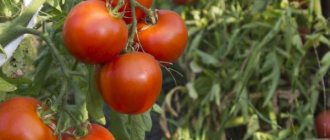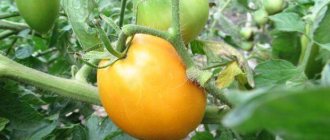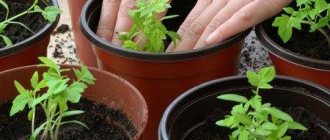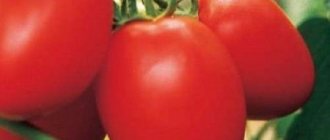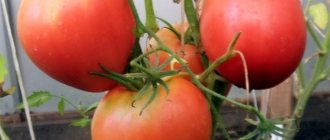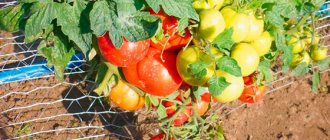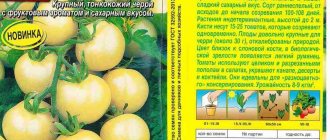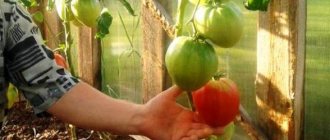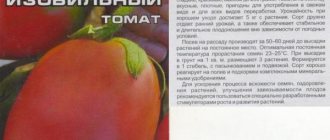Description of the Fancy tomato variety, features of cultivation and care
Growing hybrid varieties is gaining popularity. Tomato "Fancy" F1 belongs to this category. It is famous for its complex resistance to many crop diseases.
Basic ideas about the species
Before deciding to purchase a variety, many gardeners are looking for more detailed information. General provisions that are necessary to understand whether the characteristics are suitable for the specific needs of the family.
- Superdeterminant type.
- Height 45–55 cm.
- Intermediate inflorescence.
- One brush contains up to 10 fruits.
- Ripens within 100–110 days.
- The color of the fruit is red.
- Shape: oblong.
- Vegetable weight 75–80 g.
- The density is high.
- They have 2–3 cameras.
- The taste is excellent.
- They fit perfectly.
- They endure transportation while maintaining their presentation.
How to plant and care for a plant
Growing Fancy tomatoes is no different from any other variety. The seedling growing method is the most common, since a bush planted in this way forms ovaries faster. Seeds are sown in advance. Approximately 55–65 days. The sowing time is calculated taking into account the climatic characteristics of the growing region.
Mandatory agrotechnical practices when growing seedlings:
- Light and warmth. Temperature 5 days after germination +15–17 ⁰С, then increase to +20–22 ⁰С.
- Feeding that stimulates the growth of seedlings.
- Dive in phase 2 of a true leaf.
- Hardening 1–2 weeks before transferring to the ground.
5–6 plants per 1 m2 are planted in a permanent place. No pinning is required, but gartering is required. It is recommended to feed the plants with organic fertilizers and mineral compounds.
Loosening, hilling and mulching of plantings will help retain moisture longer and prevent the development of diseases.
Use in home cooking. Harvest volume
Universal Fancy tomatoes are used for any type of processing, drying, and canning. Particularly suitable for whole-fruit pickling. Fresh salads, festive table decorations, this is not the entire list of vegetable uses.
The yield of the variety is 12 kg per 1m2.
The declared volume of harvest can be obtained only after the necessary agrotechnical practices have been completed.
Disease susceptibility
According to the description of the Fancy variety, it is immune to some diseases.
- Fusarium.
- Verticillium.
- Bacterial spotting.
Among pests, it is not afraid of nematodes.
Against other diseases and insects, they should be treated with medications in a timely manner.
What summer residents say about Fancy tomatoes
An important role in making the final decision is played by the reviews of those gardeners who have encountered this variety. In addition, you can get recommendations on growing or caring for them.
Tomatoes, medium ripening, are the most common in many areas. All that remains is to choose the size, color and other necessary characteristics. Fancy tomato satisfies many needs.
Transnistrian tomatoes
Solaris in many ways surpassed the famous Moldavian Perseus. Bright red Solaris tomatoes do not have the characteristic green spot around the fruit stalk of Perseus, and are significantly superior to it in yield. However, quality indicators make both tomato varieties suitable for long-term storage and transportation.
Solaris is approved, according to the register of the Russian Federation, for cultivation without shelters in the North Caucasus and East Siberian districts. Suitable for cultivation on an industrial scale and mechanized harvesting. Main characteristics of the fruit:
- large (up to 170 g);
- shelf-stable (stored for up to four months);
- tastes sweet with a slight sourness;
- the fruit has 3–4 chambers;
- tomatoes are used for preparing fresh salads and canning tomato juice.
By substance content:
- sugar 3.3%;
- dry matter 4.9%.
Solaris tomatoes are flat-round in shape, weak ribbing, smooth skin. 5-7 pieces are tied on the tassels. Productivity per 1 sq. m 6 kg, from 1 ha they collect up to 539 c.
Care
Do not forget about regular weeding, loosening and the use of organic fertilizers. Especially before flowering and the beginning of the ripening of the first fruits.
“Winter cherry” prefers organic fertilizers from rotted manure or plant residues, which are added to the soil during loosening and watering. Water as the soil dries out.
Usually, the “Winter Cherry” tomato manages to bear fruit before virus outbreaks, but if the disease suddenly catches on, it is enough to treat it with fungicides that contain copper. To prevent aphids, a single treatment with an insecticide or an infusion of wormwood with garlic is sufficient.
Growing technology
You don’t need to spend a lot of time growing Solaris grapes. You just need to follow a few simple rules.
Bush pruning
The bush is pruned in the third year after planting. The procedure is carried out in the fall, after the leaves naturally fall, or in early spring. Pruning is necessary to improve the quality and size of the berries. Since the bush is vigorous, it is recommended to trim the leaves to ventilate the clusters.
Watering should be moderate. Excess water in the soil leads to cracking of grapes. In the future, the damaged berry may become infected with rot. In hot summers, you need to pour one and a half buckets of water under one bush. Watering is done once every seven days, after the heat subsides, twice a month.
Fertilizer
You can feed the bush twice a season. The first fertilizing with organic fertilizer is done in the spring, during the period of swelling of the buds. Secondary fertilization occurs in mid-summer, with potassium fertilizers, for better ripening of the berries.
About
Solaris – variety of tomato plant
Information on the admission of Tomato Solaris from the Register of the State Variety Commission of the Russian Federation
Application for admission No. 32346, registered 1999-02-25. The Tomato Solaris variety was included in the register of approved varieties in 2000. Approved for use in the regions: North Caucasus, East Siberian.
The originator of the Tomato Solaris variety is:
Other varieties of tomato plant
Question to the portal experts
If you haven't found the answer to a question, don't hesitate to ask an expert.
Register or Login so you don't have to enter your Name and Email every time
Thanks for the comment! It will be published after checking by a moderator!
No comments yet, be the first!
A portal for those who love their dacha
Your question has been sent for moderation. Don't worry, we quickly check your questions and your question will be answered within 1 day.
We have noticed that you are already registered on our website. We recommend that you log in to view the created question.
If you don't remember your password, you can recover it.
You were not registered until today, so we have registered you. Your password has been sent to your specified mailbox.
Help our site develop!
Please read this message, it will not take up much of your time!
We so need your comments and questions to understand in which direction we should develop.
Don't forget to leave a comment if you found what you were looking for. And if you haven’t found it, use the “Ask an Expert” form in the site header. We will answer this question, and other visitors will be able to find the information that you could not find.
Your question has been sent for moderation. Don't worry, we quickly check your questions and your question will be answered within 1 day.
We have noticed that you are already registered on our website. We recommend that you log in to view the created question.
If you don't remember your password, you can recover it.
You were not registered until today, so we have registered you. Your password has been sent to your specified mailbox.
Tomato Solaris
photo by Valentina Redko
Description and characteristics of the Solaris tomato variety, reviews, photos
An early, high-yielding, low-growing tomato variety for open ground. The period from germination to the beginning of ripening is about 100 days.
The bush is of a determinate type, up to 70 cm high. It requires tying the plant to a support and partial pinching (preferably up to the first flower cluster). The leaf of this tomato is ordinary, medium in size. The inflorescence is simple. The first inflorescence is formed above 6-7 leaves, subsequent ones every 1-2 leaves.
In 2000, the Solaris tomato variety was included in the State Register for the North Caucasus region for cultivation in open ground.
Basic qualities of fruits
The fruits are round, dense, red in color at maturity, weighing 80-150 grams, juicy, good (for early varieties) taste.
These tomatoes are suitable for early fresh salads, processing, and home cooking. Advantages of tomato : high yield, excellent commercial quality of fruit, resistance to major tomato diseases.
There were many reviews on the garden forum that this variety is often grown for market sale of early tomatoes.
Features of cultivation, planting and care
Sowing the seeds of this variety of tomatoes for seedlings is carried out 50-55 days before the intended planting in the ground. Seedlings dive at the stage of two true leaves. When planting seedlings in a permanent place per 1 sq. It is recommended to place up to 5 plants per meter of plot.
Further care for tomatoes consists of timely watering, fertilizing with complex mineral fertilizer, pinching and preventive measures to protect against diseases and pests.
If you grew Solaris tomatoes, please write whether you liked them or not. What was the yield and taste of the fruits like under your climatic conditions? How do you rate the disease resistance of this variety? Briefly describe the advantages and disadvantages of this tomato in your opinion. If possible, attach a photo of your tomatoes to your comment. Thank you!
Your reviews of the Solaris tomato and additions to the description will help many gardeners evaluate this variety more objectively and decide whether it is worth planting or not.
Tomato variety Sunrise - characteristics and growing regions
Amateur tomato growers are always in search of new varieties with better characteristics. And more and more often they give preference to hybrid varieties rather than varietal tomatoes. After all, it is hybrids that are able to show the best qualities of their parent varieties, while being many times superior to them. One such successful hybrid is the Sunrise F1 tomato. Its applicants are Dutch breeders, whose work has long been appreciated by domestic gardeners. Tomato Sunrise is even included in the State Register. This happened not so long ago - in 2007.
Dutch breeders are great masters in creating varietal and hybrid tomatoes
Varietal characteristics
To truly appreciate the capabilities of the Sunrise tomato variety, you need to carefully study its characteristics.
- The variety is intended for cultivation on private farms.
- The hybrid is distinguished by an early harvest. The period from germination to the beginning of ripening of the first fruits is only 85 - 100 days, depending on climatic conditions.
- Long and stable fruiting of the variety is noted.
- The immunity of the Sunrise variety is very strong. According to the State Register, it is resistant to fusarium wilt and verticillium. There are also references to the fact that the hybrid is able to resist gray leaf spot and Alternaria cancer.
- The hybrid does not disappoint with its yield - at least 4 - 4.4 kg per bush.
- The variety adapts well to open ground conditions and is not afraid of rainy weather or cold snaps.
- Despite the fact that the variety is labeled as a salad variety, according to reviews it is excellent for pickling; juice, tomato paste and puree are made from it.
- It should also be noted that the fruits have excellent shelf life and the ability to transport the crop over long distances.
Sunrise tomato fruits are quite large, so their main use is summer salads
Growing regions
The Sunrise hybrid is approved for cultivation in all regions of Russia, which means that the variety can be successfully planted both in greenhouses and in open ground. In addition, this variety is popular in Ukraine and Moldova.
Diseases and pests
And in this regard, the variety is also impeccable. The immunity is wonderful. Solaris is not affected by tobacco mosaic and is moderately resistant to late blight, alternaria, fusarium, and stolbur. Plants resist drought and high temperatures well. If there are no potatoes nearby, the Colorado potato beetle will settle on tomatoes. It is dangerous primarily for young plants. When planting in open ground, plants must be treated with a pesticide. The beetle rarely attacks mature tomatoes.
The main preventive measure is to plant tomatoes away from potatoes and peppers. They all belong to the nightshade family and share common diseases and pests. There is no need to plant tomatoes in areas where these crops were previously grown.
We bring to your attention useful information on the topic: How to grow a lot of tasty tomatoes in open ground? How to get excellent harvests in greenhouses all year round? What subtleties of agricultural technology of early varieties should everyone know?
Features of cultivation and care
Care consists of regular application of fertilizers and water. Plants of this variety do not require pinching. To prevent the fruits from falling to the surface of the ground, they should be tied up.
Watering
With regular watering, the Solerosso tomato produces a large harvest. For tomatoes, soil moisture should be 90%. If there is little water, the tops dry out, prolonged heat leads to the destruction of inflorescences and ovaries. But don’t get carried away and overwater the bushes; with a large amount of water, they quickly pick up fungal diseases.
The tomatoes are watered for the first time immediately after transplanting into the soil, then the procedure is carried out once a week. Plants need a lot of water during flowering. Water in the morning or evening; after watering, be sure to loosen the soil to allow the root system to fully absorb not only moisture, but also air.
Top dressing
With high-quality and constant fertilizers, the plant produces a stable harvest. Mineral products and folk recipes are used as fertilizers. The main microelements are potassium and phosphorus. Phosphorus accelerates metabolism in plants and ensures normal development of fruits. Add in the form of superphosphate (40 g of product per 10 liters of water).
Potassium is responsible for the taste and is added as potassium sulfate (30 g per 10 liters of water). Both are root feedings. During the flowering of the Solerosso hybrid, a weak solution of boric acid is used (1 g per 10 liters of water).
As for traditional methods, the best results are achieved by fertilizing tomatoes with wood ash; you can simply add it to the ground or water it with an infusion based on it.
Protection from diseases and pests
Many gardeners claim that Solerosso tomatoes have strong immunity, so there is no need to be particularly afraid of diseases. But in order to avoid even the slightest risk of illness, it is necessary to follow a number of preventive measures:
- Water the plants in a timely manner.
- Apply sufficient fertilizer.
- Ventilate the greenhouse to avoid high humidity.
In open soil, tomatoes are attacked by aphids, mole crickets and thrips; use special means to get rid of them. For example, laundry soap and tobacco work well against aphids, and ammonia helps against slugs.
Harvesting
You can tell when the fruit is ripe by its appearance. Tomatoes acquire a rich red tint and uniform color. They do not have various spots of a different color. Solerosso hybrid tomatoes ripen in batches, so they need to be removed from the plants approximately once every 4 days.
Basic agricultural technology
The seeds of the variety are sown for seedlings in the second ten days of March. By the first half of May, the seedlings will be ready for open ground. Planting is carried out according to the scheme: 50x40 cm. Per 1 square. m leave 7–8 plants. Film shelter is necessary for the period of spring frosts and low temperatures, when the threats have passed - the film is removed from the tomato.
The seedlings are watered 1 hour before planting - this makes them easier to remove from the containers. Tomatoes are placed in the prepared holes, deepening the main stem by 4–5 cm, which is necessary for the formation of a strong and branched root system of the variety.
The first application of liquid fertilizer is scheduled after 10–14 days. At the same time, the top layer of soil is mulched with straw, sawdust or covered with non-woven agricultural materials.
According to the characteristics, determinate tomatoes of the Solaris variety do not require tying, but to prevent the stems from bending under large fruits, supports are installed. Bushes can be formed into one or two trunks. The peculiarity of determinate tomatoes is the formation of a flower cluster at the end of the stem. Further, the stepson will continue to grow; it must be correctly identified and left.
The Solaris variety has no growing difficulties. A good harvest of ripe tomatoes is collected not only by experienced gardeners, but also by novice summer residents.
source
One of the most popular and high-quality varieties of Moldovan selection is the Solaris tomato. It is included in the State Russian Register and is suitable for cultivation both in open ground and in greenhouses and hotbeds. This type of nightshade is distinguished by its unpretentiousness and good adaptive qualities. The Solaris variety is suitable for cultivation in the East Siberian and North Caucasus regions of the country.
In order to get a strong plant and a rich harvest, you need to competently and competently approach the cultivation and care of tomatoes. The manufacturer placed a description of the Solaris variety and recommendations for growing on the package of seeds.
Quality preparation
Even when planting very productive tomato varieties, it is necessary to prepare the soil in advance.
Before making the beds, treat the soil with a solution based on copper sulfate (it can be replaced with copper oxychloride). The solution is prepared as follows: add 1 tbsp to 10 liters of water. l.
any of these drugs. Watering the area should be moderate. For each square meter of soil you can use about 1-1.5 liters of the mixture.
Next, the soil is fertilized. Organic and mineral fertilizer must be applied to the above area of clay or loamy soil. The composition of the organic mixture includes:
- humus manure (bucket or 10 l);
- peat (10 l);
- sawdust (10 l).
A mixture of mineral fertilizer is made from superphosphate (2 tbsp) and potassium sulfate (1 tbsp). The last component can be replaced with wood ash (2 tbsp).
Next, you need to dig up the soil and water it with a manganese solution (it must be hot). 4 liters of solution are used for each square meter. The preparation of the beds is carried out 5 days before planting the plant in the ground.
To get beautiful fruits in abundant quantities, you need to do all the activities on time. In open ground, seedlings will do well if planted in cloudy weather or in the evening. During the night, the plant will be able to get a little stronger, adapt to new conditions, and normally perceive the effects of sunlight the next day.
I. Hybrids
Hybrid tomatoes are virtually guaranteed to be resistant to diseases and bad weather conditions, which is something that non-hybrid varieties suffer from. Greenhouses and greenhouses are valued for storing heat, but in them tomatoes can suffer from too high temperatures and sudden temperature changes. In recent years, world selection has been aimed at producing “heat-resistant” hybrids with a reliable guarantee of ovary production.
Hybrids are especially helpful in a greenhouse or a small garden plot where there are no real opportunities for crop rotation and diseases are prevalent. Selection successes demonstrate confident resistance to various types of infections - viral (especially the most dangerous tobacco mosaic virus), fungal, bacterial. In addition, the hybrids have uniform fruits and consistently high yields.
Tomato Incas F1
One of the best hybrids for canning whole fruits without skin. Popular early high-yielding bush hybrid. The plant is medium-sized, compact.
Tomato from the Dutch company Numens, zoned in Russia; entered into the state register in 2000. Mid-early hybrid (105 days) of meter-high vegetables, determinate. Very high resistance to fungal diseases has been recorded. The fruits are 80-100 g, dense, bright red, pepper-shaped, fleshy, uniform, tolerate sunburn well, are very easy to ripen, transported over long distances without loss of quality.
Tomato Torquay F1
Dutch hybrid from Bejo Zaden; in the Russian register since 2007. Mid-season tomato (119-123 days from germination to ripening), bush type - determinate, maximum height 100 cm. Forms abundant multiple clusters with fruits weighing 60-140 g. Dense tomatoes withstand long-term transportation, excellent in pickling and pickling matters.
Tomato Mariana F1
The tomato was created in the French branch of the Japanese company Sakata (the image of the woman Mariana is a symbol of the French Republic). The breeders of this agricultural company are often suspected of producing GMOs, but so far without real evidence. Mariana is a mid-early determinate hybrid. The fruits are similar in shape to Incas - also elongated-oval, perfectly smooth, super dense.
Tomato Bagheera F1
Hybrid from the leading French seed company Cloz. Included in the Russian seed register in 2007.
Early high-yielding hybrids are a real boon for the garden. They are cold-resistant, do not need pinching or tying up, and practically do not get sick. The ripening period is marked as medium-early; determinate bush. The fruit is round, flattened on top, ribbed, weight ranges from 80-220 g. The hybrid is resistant to soil drought and nematode, more suitable for regions located in the south. Does not suffer from fusarium and verticillium wilt.
Tomato F1 Semko 2005
The tomato is suitable for open ground and under film shelters (greenhouses). Determinate, medium-sized, compact. Resistant to soil salinity, drought, high temperatures, grows well in open ground in both southern and northern regions. Vegetables practically do not suffer from viral and fungal diseases, even late blight.
Tomato F1 Semko 2010
Included in the state register in 2010. Ultra-early ripening determinate hybrid - 85-88 days pass from the sprouting of green vegetables to the coloring of fruits. The first brush is formed immediately after the sixth leaf grows. The fruits are incredibly dense for such an early tomato, and are by no means small - 130 g. The shape is round hearts with a beautiful pointed tip.
The newest indeterminate hybrid (on the register since 2015) - tested by us, everything is fine - created taking into account all possible greenhouse disasters. Firstly, it sets well even in the heat, as well as during temperature changes. Secondly, it is tolerant of problematic soil substrates. Thirdly, it shows high resistance to viral, fungal and bacterial infections.
The yield of vegetables varies between 20-30 kg/1 square meter. Mid-early hybrid (100 days from green shoots). The clusters begin to form after 7-9 leaves, each bears 5-6 tomatoes in the shape of rounded hearts, smooth, beautiful, attractive orange color. The weight of the “heart” is 160-190 g. The pulp contains a high percentage of dry matter, sugars, and carotenoids. The fruits are quite dense and do not wrinkle during transportation. Purpose: salad. Created as an orange variant of another hybrid - Tomato Pink Spama.
Bushes of unlimited growth, with dense foliage. Mandatory shaping is required, including a garter. Hybrid of medium early or medium ripening period (112-118 days). Clusters of 6-8 tomatoes weighing 130-150 g. The fruits are plum-shaped, slightly tapering downwards. They are deep red in color, thick-skinned, with a high percentage of dry matter.
Tomato Empire F1
Indeterminate hybrid of a new generation, in the state register since 2011. Medium-early (100 days - 2 days - from germination). The plant is tall, much taller than other types of tomatoes. Therefore, the tomato requires gartering and pinching. Tomatoes are oval-shaped with a spout, weight ranges from 80 to 140 g. On average, 9 kg are obtained per bush. The color of the fruit is red-orange. The skin and pulp are dense. Can be stored for 6-7 weeks. In greenhouses people do not suffer from viral and fungal infections.
On the register since 2015. The bushes are semi-determinate, beautiful, a meter and a half high. Suitable for any soil - open or closed. Plants require pinching. Multiple clusters bear up to 30 fruits with a sweet taste and a perfect “strawberry” shape. The weight is typical for classic cherry tomatoes - 25 g. Thanks to the strong skin, the fruits can be stored for a long time. Early hybrid: ripe fruits appear 91-93 days after the sprouts emerge. The plant is resistant to Fusarium wilt.
Tomato F1 Kaspar
The bush is short, usually up to the first cluster, 60 cm. The fruits of the plants are cylindrical with a spout, the length varies around 11 cm, and the weight is 95-115 g. They are very dense, without juice. It is convenient to pickle them assorted with cucumbers of a similar size.
The average ripening period is 115 days. The hybrid is intended for open ground, or is planted under low shelters; We plant three to four vegetable bushes per square.
Tomato Aunt Valya F1
Valya f1 tomatoes are early-ripening, tall hybrids with average yield. The bushes easily and quickly reach a height of 200 cm. In the register since 2015. Productivity is within 20 kg per square meter. On average, one bush produces 7 kg of tasty and beautiful tomatoes. Tomatoes ripen simultaneously, reaching 200-250 g in weight.
The fruits have a regular round, slightly oblong shape. The scope of use of tomatoes is very wide. Salads are prepared from the first fruits. As the volume of the harvest increases, the fruits are used for winter harvesting, as well as juices, ketchups, pastes, sauces and lecho. Tomatoes retain commercial quality for a long time and tolerate transportation and long-term storage well.
Outdoor care
The variety needs careful care due to its weak root system.
It is especially important to observe the frequency of fertilizers and humidity conditions
Watering
Watering should be carried out at the root; during drought, you can additionally spray the plants. This should be done in the evening so that the sun does not burn the leaves. Water the bushes as they dry (10 cm of the top layer of soil). If there is enough rain, watering is reduced, and the bushes can only be hilled.
Feeding
Until the flowering period, fertilizers applied to the soil before planting are sufficient. When forming inflorescences, the drug “Kemira-universal” is added to the soil (at the rate of 30g/m2). In the active flowering phase, feed every 15 days with an aqueous solution of the drug “Kristalon” in a ratio of 10g / 10l.
During the fruiting period, fertilize with Kristalon once every three weeks, reducing the amount of the drug to 2 g.
Stepsoning
The plant is formed into two stems, and in order not to thicken the planting, pinching is carried out. It is better to remove unnecessary shoots using garden shears, having previously disinfected them. The cuts must be treated with crushed coal.
Soil care
After watering, the soil is loosened, saturating it with oxygen. Deep loosening is not recommended: the roots are located superficially. It is imperative to remove weeds that draw moisture and nutrients from the soil.
If you don't have time to care for plants, you can use mulch made from straw or sawdust. Such a coating will retain moisture in the soil longer and will inhibit the growth of parasitic plants.
Tying up a bush
When grown in warm climates, you can do without tying, since the bushes do not grow too much.
Find out how to properly tie tomatoes.
In cold regions, the plant stretches towards the sun, the branches become thinner. To prevent the stems from breaking under the weight of the fruit clusters, it is advisable to tie them up.
Each bush is tied separately, using a wooden peg as a support. The braid should not be too thick so as not to injure the stems.
Preventative treatment
"Andromeda" has a strong immune system, but can still be affected by diseases due to errors in care.
Prevention measures are as follows:
- disinfection of seeds and soil;
- compliance with crop rotation;
- compliance with landing frequency;
- pinching to prevent thickening;
- timely feeding;
- treatment with 1% Bordeaux mixture (every three weeks after planting in the ground)
- dusting the soil with wood ash;
- treating the soil with a solution of potassium permanganate after harvesting.
Important! Preventive treatments cannot be carried out during fruiting. Prevention from pests is compliance with humidity and planting density
Prevention from pests is compliance with humidity and planting density.
Plants that secrete phytoncides that have an unpleasant aroma for parasites can repel insects:
- calendula;
- sagebrush;
- garlic.
If pests appear, you should purchase the drug “Aktara” or “Fitoverm”. Both destroy most parasites, including the Colorado potato beetle.
Important! When applying fertilizer to the soil, step back 10 cm from the tomato stem
Bush care
“Solaris”, although an unpretentious variety, requires care. He needs:
- Timely watering. However, you need to ensure that the roots of the bushes do not become overly flooded and do not rot;
- Fertilizer application. The first time liquid fertilizer is applied 14 days after planting the seedlings in a permanent place;
- The bush needs support and the plant is tied to it as it grows;
- Correct formation of the plant;
- Preventive measures against the occurrence of pests and diseases.
Tomato Udachny: characteristics and description of the variety with photos
Early tomatoes are a source of pride for a summer resident. The “Udachny” tomato will delight you with its first fruits by the end of the first month of summer.
Basic ideas about the variety
The detailed characteristics of tomatoes are intended to help the novice gardener not to make mistakes when growing. By studying the features and strictly following the recommendations, you can get record yields from any bush.
Plant:
- Bush: determinate.
- Height: 60–80 cm.
- Quantity per brush: 7–9 pcs.
- Ripening time: 95–105 days.
Fruit:
- Shape: round:
- Weight: 150–200 g.
- Color: red.
- Density: high.
- Taste: excellent.
- Transportability: high.
- Shelf life: 1–1.5 months.
Planting and caring for plants
Tomatoes of the “Udachny” variety are planted in open ground and greenhouses; the seedling growing method is recommended. To keep the plant strong, it is best to prick the seedlings. This is done when 2 true leaves have fully formed on it.
Before planting in the ground, you can harden off the tomatoes, because this way they will experience less stress when transplanted to a permanent location.
Many tomatoes love sunlight, so the area for growing them should be well lit, preferably protected from gusts of wind.
There is no need to shape the plant; it can be planted if desired or absolutely necessary. From 4 to 6 plants of the “Udachny” variety are planted per 1 m2.
Weeding, loosening and hilling are carried out as needed. They do this mainly to prevent diseases.
Watering is standard for the crop, with warm water in the evening.
Harvest volume and application
The description shows that one plant can produce 3.5 kg of fruit. Only if all basic agrotechnical practices are performed.
The use of tomatoes is universal; they are planted for whole-fruit canning and for processing. They are used to make juices, ketchups, sauces and tomato paste. And consumed fresh in salads.
Disease susceptibility
Plants of the variety are immune to blossom end and root rot. Against other pathogens, preventive measures and treatment with special preparations are used.
Positive and negative aspects of the species
Tomatoes, the characteristics of which have more positive properties and features, are chosen by summer residents much more often. Therefore, to evaluate the variety, the following division is made:
Pros:
- Resistance to some diseases.
- Harvest volume.
- Undemanding to the formation of a bush.
- The fruits do not crack, are stored for a long time and can be transported over long distances.
Minuses:
Preventive treatment against diseases and pests.
Opinions of summer residents regarding the “Udachny” tomato
Reviews regarding the variety provide the inexperienced gardener with a lot of useful information. Based on which, he decides whether to plant tomatoes or not.
- Angelina. I grew a few bushes to try. Tomatoes have proven themselves to be excellent. Next year he plans to increase the number of bushes. I especially liked the canned fruits.
- Andrey Vasilievich. Recommends it to all summer residents I know. I like the taste of tomatoes. Considers them a variety for the lazy. They require virtually no maintenance.
Every gardener has his own favorite tomatoes. Those who planted the “Udachny” tomato variety are most often satisfied with everything. And this variety is firmly among the first rows of selected species for planting.
Description of the variety
The tomato is a mid-early variety. The fruits ripen 100-105 days after the first shoots appear. In general, Solaris has the following characteristics:
- The bush is powerful, but not tall. Reaches approximately 80 cm in height;
- The leaves are not large, dark green in color. There are not too many leaves on the bush;
- The inflorescence is simple and it appears above the 5th-6th leaf;
- The fruits are bright, red, not ribbed, but have a beautiful round shape. The skin is smooth. Weight of tomatoes is 120-170 grams. They have 4 cameras. The taste is sweet with a slight sourness. The fruits are also quite aromatic.
Types of lavender
The genus Lavender is a representative of the Lamiaceae family and includes up to forty-seven species of plants. In the wild, this plant is found in East and North Africa, southern Europe and the Canary Islands, India, Australia, and Arabia. But cultural forms of lavender are widespread throughout the world.
Lavender cultivated can be divided into two large groups:
– French (broadleaf, medicinal, Lavandula latifolia (stoechas))
– English (narrow-leaved, Lavandula officinalis (angustifolia))
Lavender latifolia
Back in the Middle Ages, this plant was cultivated in the south of France, where it got its name. In those days, lavender was used only as a source of essential oil, which was used for perfumery, medicinal and veterinary purposes. They also used lavender oil to make a special varnish for painting porcelain.
Broadleaf lavender is considered a rather capricious and heat-loving plant. Its flowers are larger than those of the English one, and are represented in a very wide range of colors - all kinds of shades of white, pink, burgundy, purple, and lilac. The aroma of French lavender is quite bright, but less refined than that of its narrow-leaved sister. The “Frenchwoman” blooms quite early - in April or May, and is pleasing to the eye until mid-summer. It happens that at the end of summer broadleaf lavender blooms again.
Lavender angustifolia
This is a more frost-resistant plant, which in the southern regions of Russia, Ukraine, and Belarus does not require digging in late autumn. For six centuries, the cultivation of angustifolia lavender was the privilege of princely and monastic gardens as a medicinal plant. Narrow-leaved lavender contains less oil than broad-leaved lavender, but it is considered more healing and its aroma is more refined.
It is English lavender oil that is used by perfumers around the world to create exquisite perfumes, expensive soaps, lotions, shampoos, and colognes. Dried flowers of this plant, along with jasmine and rose petals, are added to expensive varieties of flower teas.
Lavender angustifolia is a perennial shrub with a fibrous woody root and a large number of shoots up to 60 cm high. It has narrow, dense, gray-green-silver leaves with a delicate fluff. The flowers are not large, mostly blue, blue, lilac, collected inflorescences in the form of a spike of six to ten pieces. English lavender blooms in July-August.
General characteristics of the variety
Solaris tomatoes are mid-season varieties. This species is determinate; an adult bush does not reach more than 80–90 cm in height.
The plant has a compact and neat appearance; Its foliage is average. The leaf is ordinary in shape and has a deep green color. The tomato inflorescence is simple; the first ovary is formed above the 6-7 leaf, then after 1-2 leaves.
The Solaris variety has an articulated stalk. After the formation of 4-6 inflorescences, the bushes stop growing on their own. The plant has good immunity and is resistant to many diseases, such as late blight, fusarium, alternaria and TMV. The Solaris tomato variety is considered unpretentious. It tolerates minor changes in air and soil temperatures well. The culture does not cause much trouble in care.
The fruits of this type of nightshade have a flat-round shape with slight ribbing. The tomato is covered with a dense, smooth and shiny skin. It protects the fruit from scorching sun rays and from cracking. Thanks to its properties, tomatoes are stored for a very long time, on average about 4 months. They tolerate long-term transportation well.
The average weight of 1 tomato is about 170 g. The fruits of Solaris tomatoes are quite large, so the bush needs garter and additional support, although many gardeners do not consider this a prerequisite. On average, about 5-6 pieces are tied on 1 tassel. The fruits have 3-4 chambers, are red in color, without spots around the stalk.
The taste of tomatoes is excellent. They have a sweetish-sour taste with spicy notes. The tomato is suitable for universal use. Juice, paste, lecho and vegetable salads are prepared from it.
The Solaris variety is suitable for cultivation for production purposes and is suitable for mechanized harvesting.
source
Not a variety, but a gift to the gardener! What is it about? Of course, about the Solaris tomato variety. More details about unpretentious and productive, and most importantly tasty tomatoes can be found in this article.
Tomato variety "Solaris":
Description of the harvest
Solaris surpassed another popular variety of Moldavian selection, Perseus, in many characteristics.
Unlike the latter, the rich red fruits of the Solaris variety do not have a green spot near the stalk. In addition, it significantly surpasses Perseus in terms of harvest quantity. But both varieties are characterized by good transportability and a long shelf life. Gardeners who grew Solaris tomatoes on their plots describe the resulting harvest as follows:
- The fruits are large, each weighing up to 170 grams.
- The harvest is stored for a long time (up to 4 months).
- Tomatoes of this variety have a flat-round shape.
- The skin is smooth.
- The fruit contains about 3.3% sugar and 4.9% dry matter.
- The taste can be described as sweetish, with slight sourness.
- Each tomato contains three to four seed chambers.
- Fresh vegetable salads, tomato juices are prepared from the fruits, and they are also canned.
The plant produces 5-7 fruits on each cluster. From one square meter you can harvest about 6 kilograms of crop.
tomato Superstar - description and characteristics of the variety
